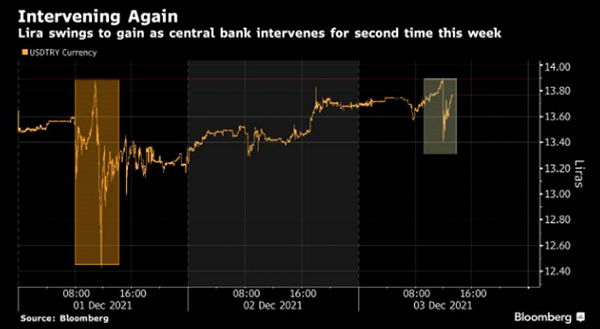By Natalia Gurushina
Chief Economist, Emerging Markets Fixed Income Strategy, VanEck
Turkey’s inflation continues to climb higher on the back of the rapidly depreciating currency, but price pressures in wider EM are not yet subsiding.
It was a familiar picture this morning – the Turkish lira underperforming emerging markets (EM) peers (despite another day of reported currency interventions – see chart below). The reason “du jour” was above-consensus inflation – which, frankly, should not have been that surprising, given the currency’s mega-depreciation in the past three months, but here we are. Annual headline inflation surged to 21.31% in November, and some analysts expect it to peak at around 26% (or even higher) in 2022. The biggest question is whether the central bank will continue to cut rates under this scenario – the rate-setting meeting on December 16 will be closely watched – but rating agencies are already up in arms. Fitch just lowered Turkey’s outlook to negative, specifically quoting the “premature monetary policy easing cycle” and saying that the currency’s “unprecedented intra-day volatility” creates risks to macroeconomic and financial stability.
Now, we all know that Turkey is a rather special case – a typical policy mix in a major EM is much more connected to reality (=orthodox) these days. Still, the latest releases show that inflation pressures in wider EM continue to persist. Sometimes, they are driven by one-off factors (like South Korea’s fuel tax increase), but sometimes the reasons look more permanent. Another sizable increase in Mexico’s minimum wage (reported 22%) falls into the latter category, creating additional challenges for the newly-confirmed governor of the central bank (Victoria Rodriguez).
The inflation backdrop in Asian economies looks more benign – they generally managed to avoid EMEA-like or LATAM-like inflation surges, and in many countries headline inflation is still within the target range. This gave rise to suggestions that, perhaps, the region would not have to tighten as aggressively as elsewhere in EM, minimizing the negative impact on growth in 2022. In this regard, Thailand’s inflation print looked reassuring – edging higher but staying within the target. But with food and energy prices accounting for over 50% of the consumer price basket, the country (and the central bank) are not yet out of the woods. Stay tuned!
Chart at a Glance: Turkey FX Interventions Continue

Source: Bloomberg LP
Originally published by VanEck on December 3, 2021.
For more news, information, and strategy, visit the Beyond Basic Beta Channel.
PMI – Purchasing Managers’ Index: economic indicators derived from monthly surveys of private sector companies. A reading above 50 indicates expansion, and a reading below 50 indicates contraction; ISM – Institute for Supply Management PMI: ISM releases an index based on more than 400 purchasing and supply managers surveys; both in the manufacturing and non-manufacturing industries; CPI – Consumer Price Index: an index of the variation in prices paid by typical consumers for retail goods and other items; PPI – Producer Price Index: a family of indexes that measures the average change in selling prices received by domestic producers of goods and services over time; PCE inflation – Personal Consumption Expenditures Price Index: one measure of U.S. inflation, tracking the change in prices of goods and services purchased by consumers throughout the economy; MSCI – Morgan Stanley Capital International: an American provider of equity, fixed income, hedge fund stock market indexes, and equity portfolio analysis tools; VIX – CBOE Volatility Index: an index created by the Chicago Board Options Exchange (CBOE), which shows the market’s expectation of 30-day volatility. It is constructed using the implied volatilities on S&P 500 index options.; GBI-EM – JP Morgan’s Government Bond Index – Emerging Markets: comprehensive emerging market debt benchmarks that track local currency bonds issued by Emerging market governments; EMBI – JP Morgan’s Emerging Market Bond Index: JP Morgan’s index of dollar-denominated sovereign bonds issued by a selection of emerging market countries; EMBIG – JP Morgan’s Emerging Market Bond Index Global: tracks total returns for traded external debt instruments in emerging markets.
The information presented does not involve the rendering of personalized investment, financial, legal, or tax advice. This is not an offer to buy or sell, or a solicitation of any offer to buy or sell any of the securities mentioned herein. Certain statements contained herein may constitute projections, forecasts and other forward looking statements, which do not reflect actual results. Certain information may be provided by third-party sources and, although believed to be reliable, it has not been independently verified and its accuracy or completeness cannot be guaranteed. Any opinions, projections, forecasts, and forward-looking statements presented herein are valid as the date of this communication and are subject to change. The information herein represents the opinion of the author(s), but not necessarily those of VanEck.
Investing in international markets carries risks such as currency fluctuation, regulatory risks, economic and political instability. Emerging markets involve heightened risks related to the same factors as well as increased volatility, lower trading volume, and less liquidity. Emerging markets can have greater custodial and operational risks, and less developed legal and accounting systems than developed markets.
All investing is subject to risk, including the possible loss of the money you invest. As with any investment strategy, there is no guarantee that investment objectives will be met and investors may lose money. Diversification does not ensure a profit or protect against a loss in a declining market. Past performance is no guarantee of future performance.







